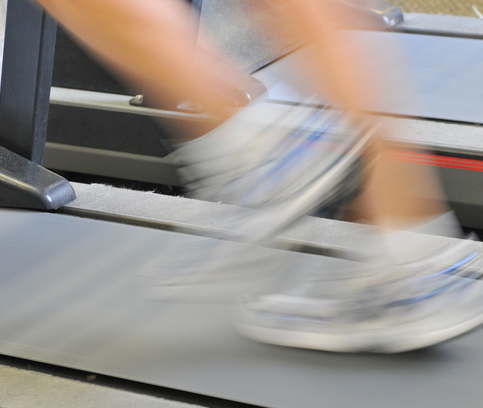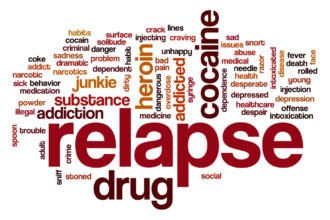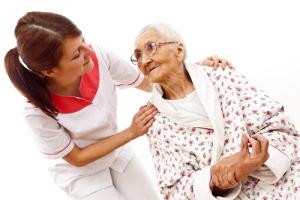
By Dr. Nalini Chilkov.

By Dr. Nalini Chilkov.
Dr. Nalini Chilkov, founder of The Amrita Institute for Integrative Cancer Care. This article was first published in the PeerTrainer website, and I think our readers will find it pretty compelling. DM
Leading edge integrative oncologist Keith Block MD feels so strongly about the benefits of exercise to cancer patients that he encourages his patients to get on a treadmill during their chemotherapy treatments in his clinic!
Gone are the days when cancer patients and cancer survivors convalesce and loll about.
The American Cancer Society issued new healthy living guidelines for cancer survivors (I prefer the term cancer thrivers!) promoting regular physical activity and a healthy diet based on fresh whole foods:
“Many studies have shown that being physically active has a tremendous impact on quality of life of cancer survivors. Now, studies have demonstrated that physical activity after cancer diagnosis is also associated with a lower risk of the cancer coming back and improved overall survival among multiple cancer survivor groups, including breast, colon, prostate, and ovarian cancer.
Among breast cancer survivors, a recent analysis showed that getting exercise after diagnosis was associated with a 34% lower risk of breast cancer deaths, a 41% lower risk of dying from all causes, and a 24% lower risk of breast cancer recurrence. Among colon cancer survivors, studies suggest exercise cuts deaths from colon cancer and all causes, and cuts the risk of the cancer coming back by up to 50%”.
In fact, according the National Cancer Institute moderate physical activity may strengthen the immune system, reduce the risk of cancer development, and may reduce the growth, development, and recurrence of cancer.
How Much Exercise Do You Need For These Benefits?
The Center for Disease Control and Prevention recommends at least 30 minutes of moderate intensity exercise five or more days or 150 minutes per week. The new American Cancer Society guidelines also include strength training exercises (to build and tone muscle) at least 2 days per week.
Many studies show that the greatest reduction in cancer risk is found in those who engage in the most physical activity, regardless of weight or body mass index.
So, exercise in and of itself transforms cancer risk and enhances immune robustness. A lifetime of regular exercise has the most benefit, but it is never too late to start!
How Does Moderate Exercise Impact Cancer Risk?
Moderate exercise can impact cancer risk by…
1. Maintaining a healthy weight. Increased body fat increases risk of cancer. Body fat acts as a depot for producing inflammation and hormones that contribute to a pro-cancer physiology. Overweight, overfat, and obese individuals have increased rates of cancer and cancer recurrence.
One reason body fat contributes to cancer growth is that it contributes to increased levels of inflammatory factors such as COX2 and LOX5, C Reactive Protein and the cytokine Interleukin-6 all of which contribute to a pro-cancer environment.
Related PEERtrainer article: How to Reduce Inflammation
2. Maintaining normal blood sugar metabolism and normal insulin signaling and reducing the risk of diabetes. Elevated blood sugar, diabetes, and pre-diabetes, also known as insulin resistance or metabolic syndrome, can fuel cancer growth. Diabetics with chronically elevated blood sugar, insulin and Insulin Like Growth Factor (IGF-1) levels have increased risk of cancer and cancer progression. Why? Cancer cells preferentially utilize sugar as a fuel.
The more sugary your blood, the more ready fuel for cancer cell growth. Elevated insulin and IGF-1 levels also promote cancer cell growth. Exercise not only reduces body fat and increases percent muscle mass, but also influences hormone signaling to normalize blood sugar metabolism. The key is here is MODERATE exercise. Very intense exercise can trigger the release of cortisol, a hormone that elevates blood sugar.
3. Maintaining healthy bones and muscles. Maintaining muscle mass is crucial to cancer survival. The loss of muscle mass is a risk factor for cancer progression. By maintaining healthy bones, there is less bone loss and fewer fractures. Healthy bone is also more resistant to invasion by cancer cells and the spread of cancer to the bone (bone metastases).
4. Maintaining a Robust Immune System. Research supports the link between regular moderate exercise and a strong immune system. Physical activity promotes production of immune cells, including Natural Killer Cells which target both tumor cells and viral cells. Some cancers are linked to viral infections. For example, both cervical cancer and head and neck cancers of the mouth and throat are linked to Human Papilloma virus.
Warning: Moderate exercise can boost immune system function, but intense exercise can have the opposite effect.
5. Maintaining Healthy Hormone Levels. Exercise may lower cancer risk by lowering insulin and insulin like growth factors, which are both cancer promoting hormones. Increased body fat is coupled with increased estrogen production from fat cells. Estrogen is related to breast, uterine and prostate cancers. By maintaining normal weight and body fat the risk of increased estrogen levels is reduced.
6. Maintaining Healthy Mood and Emotions. Exercise has both psychological and biological effects on mood, including feelings of depression, anxiety and fatigue. This of course impacts quality of life.
7. Maintaining a Strategy of Stress Management. Exercise can reduce psychological stress and tension, but exercise also has a biological impact on stress. Because ongoing stress may diminish the strength of the immune system, moderate exercise supports a normal immune system that more readily recognizes and destroys cancer cells.
Additionally, stress can lead to the production of proinflammatory chemicals that can impair normal immune function and promote cancer growth. Strategies which manage stress contribute to more normal immune and inflammation modulation. Increased inflammation has also been linked to increased risk of depression and feelings of fatigue.
8. Maintaining an Anti-Cancer Health Promoting Lifestyle:
*Cancer patients who exercise regularly are able to complete their treatments and suffer less side effects compared to patients who are sedentary. *Cancer patients who exercise have overall better rates of survival and lower rates of recurrence. *Cancer survivors who maintain an active lifestyle have lower rates of new cancers. *Cancer patients who exercise regularly have lower levels of biological markers related to cancer growth and progression. *Cancer survivors who exercise are Cancer Thrivers and report increased quality of life.
Research has demonstrated strong associations between sedentary lifestyle, levels of physical activity, obesity, and cancer risk, recurrence, and death. Regular moderate exercise over our lifetime, including during cancer treatment and recovery, can dramatically lower these factors and tip the scales towards cancer resistance and healthy function.
A minimum of 30 minutes of moderate exercise five days a week plus two days of strength training is the minimum required to shift into an anti-cancer, pro-health physiology. So, get out your walking shoes, do some gardening, go for a bike ride, climb some stairs, do some yoga or tai chi, and smell the roses!
photo:lukeurbine/shutterstock









